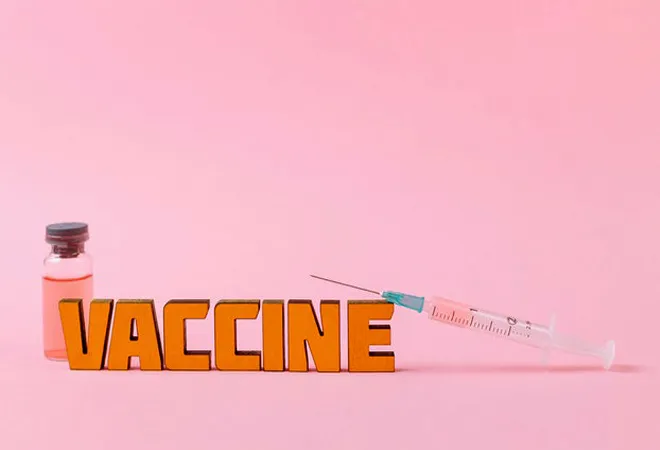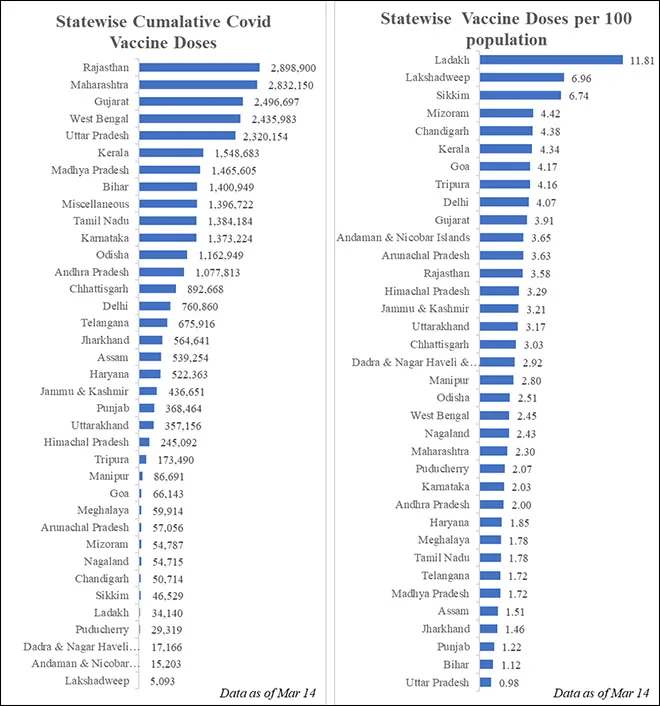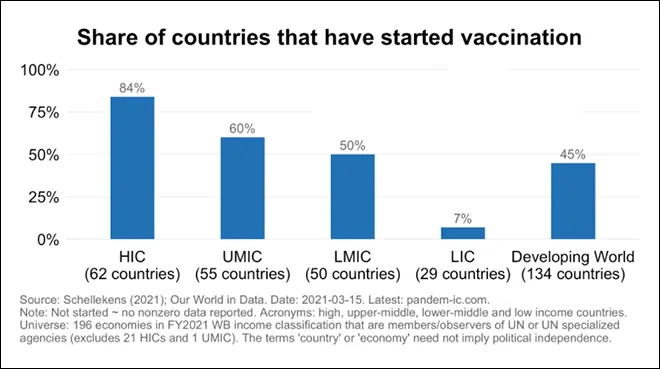-
CENTRES
Progammes & Centres
Location
In the past week, India conducted approximately 8.9 million inoculations, with an average of almost 1.27 million doses a day.

This is part of a weekly series assessing the COVID-19 vaccine rollout in India and the world.
The COVID-19 vaccination campaign is showing accelerated progress, with more than 381 million doses administered across 126 countries. The past week, roughly 66.5 million COVID-19 inoculations were conducted around the world. Inoculations across the world rose by 35 percent, as of 14 March, as compared to the week ending 7 March. The average daily rate of inoculations has risen to 9.10 million doses per day, almost doubling in the past month — from 5.9 million on 15 February.
Consequently, the time needed to cover 75 percent of the global population with a two-dose vaccine has witnessed a fall from five years to 3.3 years in the past month. The coverage rate has been steadily declining in the past few weeks, owing to the steady rise of inoculations per country and the number of countries inoculating.
Figure 1: Global Covid Vaccine Trend
 Author’s own, data source: Our World in Data
Author’s own, data source: Our World in DataAs of 15 March, 181 vaccine candidates are in the pre-clinical investigation stages. On the other hand, 81 vaccines candidates are under clinical trials, out of which, 22 vaccine candidates are in the final phases of testing in large-scale vaccine efficacy trials. This week, many European countries, such as Germany, France, Italy, suspended the use of the Oxford-AstraZeneca vaccine following concerns regarding the formation of blood clots post the shot. While AstraZeneca maintains that there is no causal relationship between the cases of blood clots in people who were vaccinated and the vaccine itself, many countries have halted their vaccine campaigns, awaiting further results on the safety of the vaccine. Experts from across the world have termed this as an over-reaction, as such clots are seen to be comparable in the general population.
The COVID vaccine drive continues to be dominated by the United States, with 109 million doses administered, as of 15 March, followed by China (64.9 million), India (32 million) and the UK (26 million). While the US and China lead in absolute doses administered, the countries seem to be lagging behind with 32.8 and 4.64 doses per 100 population, largely attributed to high population base. Israel’s inoculation surpassed that of other countries with 104.27 doses administered for every 100 people.
Figure 2: Country-wise Covid Vaccine Doses Administered
 Author’s own, data source: Bloomberg Vaccine Tracker
Author’s own, data source: Bloomberg Vaccine TrackerIndia has administered 35 million COVID vaccine doses. It is now the third highest country in terms of total vaccine doses administered, with ~2.3 doses administered per 100 people. In the past week, India conducted approximately 8.9 million inoculations, with an average of almost 1.27 million doses a day.
India’s average daily vaccination rate has surpassed 1.27 million this week, rising by 33 percent over the last week itself. At the current rate, India will take 4.2 years to cover 75 percent of its population with a two-dose vaccine.
After the initial lukewarm response, India’s daily inoculations observed a much-needed boost in the past two weeks. Yesterday, a record 3.03 million people were vaccinated. The rising number of cases in the country — along with rumors of a new variant in some states — has further urged the citizens to vaccinate. Reportedly, scientists have alerted authorities that a variant with mutations E484Q and L452R currently constitute around 20 per cent of over 200 coronavirus genomes sequenced from some of Maharashtra’s hardest-hit districts. However, there is no proof yet that the current surge in the state is because of these variants.
Additionally, Bharat Biotech’s update regarding the 81 percent efficacy of its vaccine on those without prior infection, may have led to the surge in inoculations. Currently, 90.7 percent of the vaccine shots in India have been Oxford AstraZeneca’s CoviShield, while 9.3 percent are Bharat Biotech’s Covaxin vaccine. In a development that will further expand India’s options, Dr Reddy’s Laboratories Ltd completed Phase 3 trials of the Russian COVID-19 vaccine Sputnik V, and results are expected in April.
Figure 3: Covid Vaccine Trends in India
 Author’s own, data source: Covid19India
Author’s own, data source: Covid19IndiaWithin India, Rajasthan has now taken the lead in COVID-19 inoculations, with 2.89 million shots, followed by Maharashtra (2.83 million) and Gujarat (2.49 million). Uttar Pradesh, the leader during the earlier weeks, has shifted to the fifth position, this week, with 2.32 million shots.
In terms of doses per 100 population, Ladakh leads with 11.8 doses per 100 people. Uttar Pradesh (0.98), is the worst faring state, relative to its population, and is yet to vaccinate 1 in every 100 people. States such as Uttar Pradesh, Maharashtra, Bihar, Kerala and West Bengal, with a higher elderly population, require acute focus on their vaccination programme. These states also account for a higher case load, and therefore need to enhance the efficacy of the vaccination drive.
Figure 4: Covid Vaccine Trends in Indian States
 Author’s own, data source: Observer Research Foundation Vaccine Tracker
Author’s own, data source: Observer Research Foundation Vaccine TrackerPost initiation of the second phase of its vaccination drive to include people over 60 years of age and those of aged 45 and above with co-morbid conditions, the average daily vaccination in India has quadrupled. As per Ministry of Health and Family Welfare, 10.2 million people over the age of 60 and 1.8 million people between 45-60 years with co-morbidities have been vaccinated as on date.
Around six million of India’s population has been completely vaccinated, as on date. However, in order attain the target of vaccinating a quarter of its population by August, India needs to keep the momentum of the vaccination programme going, by opening the vaccination drive to younger Indians and ensuring demand-supply tailbacks of the programme are smoothly managed.
Even though the number of countries that have initiated COVID-19 vaccination has increased steadily in the most, access to vaccines remains partial to high- and upper- middle-income countries.
While many African and Asian countries have only covered ~5 percent of their population with the existing vaccine contracts, most countries from North America and Europe have secured vaccine contracts to cover more than 110 percent of their population. The UK and Canada, each, have enough doses to cover three times their respective population. While the initial stages of the pandemic observed many vaccine makers promising ‘equitable access’ of the vaccines, until now, richer countries have been dominating most of the vaccine contracts.
In order to ease the supply bottlenecks, the recently launched Quad Vaccine Partnership will work with Biological E. Ltd. Of India to finance increased capacity with the aim of producing at least one billion doses of COVID-19 vaccines, to supplement global efforts like COVAX. It is also decided that the Quad partners — India, USA, Japan and Australia — will cooperate to strengthen last-mile vaccination, working across governments to coordinate and strengthen health systems in the Indo-Pacific.
This week observed a slight rise in the number of lower-middle-income and low-income countries that have started vaccinations. However, the rise remains insufficient. Figure 5 shows the lack of equity in vaccine distribution globally. After more than three months of the ongoing vaccination campaign, only 45 percent of the developing countries have initiated vaccination drives. Eighty four percent of the global population is attributed to developing countries, yet only 2.5 percent of this population has received a single dose of COVID vaccine, 3 months into the biggest vaccine drive in the world.
Figure 6: Covid Vaccine’s Inequitable Coverage
 Source: PandemIC Vaccine Equity Tracker, 15 March
Source: PandemIC Vaccine Equity Tracker, 15 MarchResearch shows that if wealthy nations are fully vaccinated by mid-2021, but only half of the developing population is vaccinated by then, the global economic loss would amount to US$ 4 trillion dollars. Although vaccine coverage across countries has almost doubled over the past two months, poor nations continue to lag.
India continues to supply vaccines to its partner countries, while ensuring that domestic requirements are adequately met. In 55 days, India has supplied over 58.3 million doses to 70 countries. Out of these, eight million vaccine doses have been gifted free of charge to over 37 countries, whereas 16.5 million doses have been delivered under the COVAX initiative.
Despite exporting substantially high number of doses, the last two weeks have seen acceleration and a considerable improvement in the vaccination numbers in India. Number of doses administered per session has improved and has reached close to 60 from 35 or so. For a fund starved system, the scale-up needed to be slow, but India is steadily reaching the momentum needed to achieve the target of inoculating its vulnerable populations by August 2021.
Already, India’s daily number of doses administered on the average, is greater than the European Union. The initial reluctance and the lackluster uptake which were, perhaps, because the virus was on the downswing is disappearing fast as high number of cases are now reported across many states. With more vaccination centres from the private sector in play, Indian numbers should soon get close to five million per day.
As opposed to many developed nations, who have been commandeering vaccine supplies exceeding their domestic needs, India continues to follow a humanitarian approach, by aiding its fellow nations. The country’s vaccine diplomacy efforts have been the key to many developing countries being able to initiate COVID vaccine drives.
The views expressed above belong to the author(s). ORF research and analyses now available on Telegram! Click here to access our curated content — blogs, longforms and interviews.

Oommen C. Kurian is Senior Fellow and Head of Health Initiative at ORF. He studies Indias health sector reforms within the broad context of the ...
Read More +
Kriti Kapur was a Junior Fellow with ORFs Health Initiative in the Sustainable Development programme. Her research focuses on issues pertaining to sustainable development with ...
Read More +